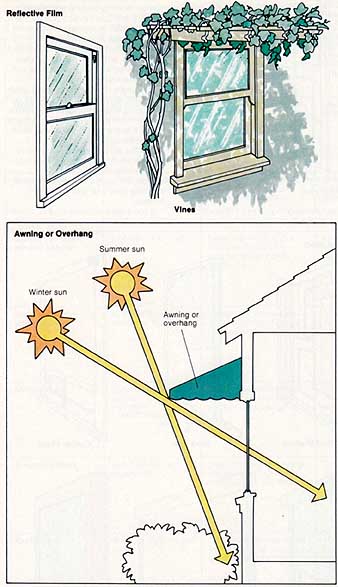There are other ways to insulate your windows besides adding layers of air between sheets of transparent glass or plastic.
For the sake of clarity, we have divided window amendments into two general categories—interior and exterior. In general, exterior amendments make less effective insulators than interior amendments because it is difficult to create a tight seal with most of them. But in combination with double glazing and /or storm windows, they can be quite effective. and there is no reason why they can’t be used with, rather than instead of, interior amendments. With some amendments, like window treatments, home energy conservation projects may build upon one another: If a single project will save you $8 per month and another will save you $12 per month, doing the two together may well save you more than $20 per month.
At the same time, consider the true usefulness of mechanical devices. For instance, the installation of rolling shutters may cost you more than the shutters will save you in heating.
• Wooden shutters: Depending on the kind of wood, a solid shutter will approximately double the insulating value of your unprotected single-pane window, at a cost of about $5 to $8 per square foot. As with foam boards, tight fit is sometimes a problem.
• Wooden louvers: Wooden louvers cost about twice what solid wooden shutters cost, and are not quite as effective as insulators. Their advantage, how ever, is that they are easily controlled to admit air and sunlight.
• Insulated aluminum louvers: Manufactured for industrial purposes but equally useful in your home, insulated aluminum louvers cost about $40 per square foot, and provide insulation com parable with that of the rolling shutters described below.
• Rolling shutters: Sold under a variety of brand names such as Roltaden and Roll-Awn, these attractive shutters—long popular in Europe—cost between $9 and $30 per square foot in materials, and will approximately triple the insulating value of your unprotected single- pane window. They are made of wood, hollow plastic, or foam-filled plastic interlocking slats that roll up to store in a box above the window. When you want to use them, just pull them down with a rope, crank them down, or release them electrically with a button. When completely closed, they form a double air space—one between the window and the shutter, and another between the outer and inner sides of the slats. Because they are guided in tracks or channels on their ends, they can achieve a tight closure over your window. Left loosely closed they provide effective shading on south-facing windows, permitting some light but little heat to enter a room through the slats.

Wooden Shutters, Rolling Shutter, Insulated Aluminum Louvers
• Shading: Some exterior amendments conserve energy by keeping the sun out of your house in hot weather, there by reducing the cooling load.
Vines, trellises, trees. Deciduous trees at south-facing windows are particularly useful—they admit sunlight in the winter when they have lost their leaves, but block it out with their foliage in the summer, keeping the house cooler.
Awnings, overhangs. Like vines, these are particularly helpful at south-facing windows. They can be built to maximize winter sunlight and minimize summer sunlight according to the latitude at which you live (see our “Solar Energy” section for ways to use the sun).

(top) Reflective Film, Vines; (bottom) Awning or Overhang:
Summer sun vs. Winter sun
Next: Interior Window Insulation
Prev: Glass Storm Windows